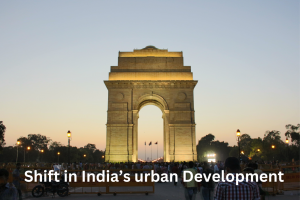ForumIAS announcing GS Foundation Program for UPSC CSE 2025-26 from 19 April. Click Here for more information.
ForumIAS Answer Writing Focus Group (AWFG) for Mains 2024 commencing from 24th June 2024. The Entrance Test for the program will be held on 28th April 2024 at 9 AM. To know more about the program visit: https://forumias.com/blog/awfg2024
Source: The post shift in India’s urban development has been created, based on the article “A new sense of urbanisation that is dominating” published in “The Hindu” on 13th March 2024.
UPSC Syllabus Topic: GS Paper 1 – Society urbanization, their problems and their remedies.
Context: This article discusses the shift in India’s urban development, focusing more on religious cities like Ayodhya, contrasting with past emphasis on industry and modernism. Shift in India’s urban development
How are colonial and new cities different?
1.Colonial cities like Mumbai and Kolkata were designed primarily for economic purposes, centered around trade, taxation, and the transport of goods. They facilitated rural to urban migration, supporting the nation’s industrial growth.
- In contrast, new cities such as Ayodhya are being developed with a strong focus on religious significance. Ayodhya, for instance, is receiving a massive investment of ₹85,000 crore for infrastructure, underlining this shift in urban development philosophy.
What is the trend in current urbanization?
- The current trend in urbanization is blending traditional workplaces with religious significance. Cities like Ayodhya are being developed not just as economic hubs but also as centers of pilgrimage and faith.
- This trend is attracting corporate investments in infrastructure. Ayodhya, for example, is witnessing heavy investment, indicating a significant shift from the traditional, industry-focused urban development.
- Unlike the past emphasis on modernism and industry, the focus now is on developing cities aligned with religious importance, marking a distinct shift in India’s urbanization approach.
What is the concern with the current trend?
Centralization of Finances: The trend shows a centralization of financial resources towards religious projects. This can lead to imbalanced economic development focused more on religious cities.
Diversion from Social Infrastructure Investment: The significant spending on religious projects, like ₹85,000 crore in Ayodhya, raises questions about the prioritization of funds. It is potentially diverting resources from much-needed social infrastructure such as education and healthcare.
Shift Away from Democratic Governance: The trend may indicate a move away from secular, democratic governance towards a religiously influenced urban development strategy.
What should be the role of the state in urbanization?
Focus on Social Good: The state should prioritize urban development that serves social good over religious purposes. This includes enhancing infrastructure for education, health, and social services.
Promoting Inclusive Urban Development: Urban planning should cater to diverse needs, ensuring inclusivity and democratic values in city development, as opposed to focusing primarily on religious significance.
Adhering to World Bank Recommendations: The World Bank has estimated that India requires an investment of $840 billion in urban infrastructure over the next 15 years. This suggests that the state should prioritize these broader developmental needs.
Question for practice:
Examine the implications of India’s shift towards emphasizing religious significance in urban development.





